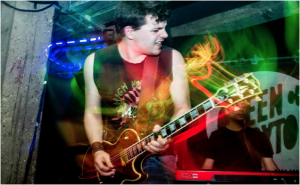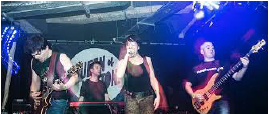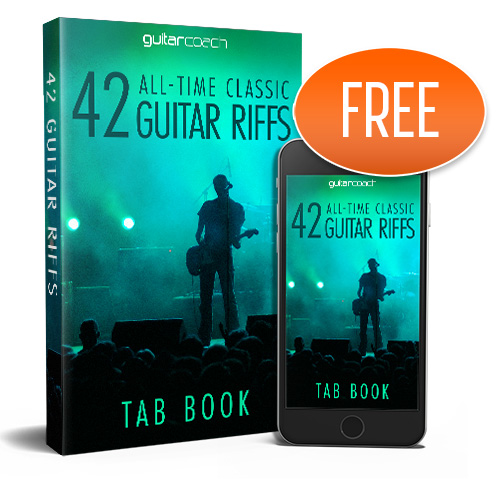Guitar Tone Control
For all guitar players playing in our rooms at home, experimenting with sounds and imitating our heroes is a unique experience, creating our own little world that consists only of us and our instrument.
For many, but not all guitar players, there will come a stage where we must step out of that little world and play what we have learned or created in front of an audience. This can come as a bit of a shock and even for seasoned live performers, there is a never ending learning curve.
This article then, is merely me sharing some mildly opinionated tips and observations, many of which I have discovered over the last six months playing with the band Rebecca Closure.
One of the big differences for many, is that whilst our guitar will probably be the same, our backline, consisting of our amplifier and any effects units, will probably be different when playing live or practicing with a band, than our practice amplifiers at home.
The Rig
Larger rigs and more complicated effects boards are addictive, as it appears to all guitarists that this is the key to our guitar heroes sounding like they do, and with studio trickery aside for a moment, this is partly true, though don’t forget it is more to do with how they use it! Below I have split my backline into my amplifier and my effects board. With Closure and for most of my playing and teaching, I use an ’87 Gibson Les Paul custom, which is all original.
The Amp
A good quality practice amp is an essential purchase for any guitar player, because it should be the amplifier we use most.
For me, there is little point in practicing scales and other daily routine practice at high volume. It also goes against all the effort I put in to protect my hearing!
This being said, when it comes to moving to a larger amplifier for getting over a drummer or playing to a full room, the amount of control required over your amplifier and guitar increases.Any of those small noises you ignored or even didn’t hear at practice volume are suddenly intolerable. Additionally there are the challenges of controlling feedback and being heard clearly without dominating other band players.
In practice with Closure, I was asked several times to turn up, but far more common was everybody turning down! Whilst it’s true that it’s important to practice at gig volume as a final rehearsal, more volume is definitely not the answer in practice. Things get muddier and it’s harder to spot area’s for improvement, not to mention as musicians we should all be saving our hearing.
Which amplifier to buy comes down to personal choice in sound, and a part of this can come from what your heroes play, but there are a few things we can all do to ensure we get the best out of our equipment
1. Keep volume’s as low as possible whilst still getting over drummers and make it easier to listen to what everybody is playing, you should always be aware and reacting to other band members.
2. To avoid degradation in signal to your amplifier, avoid unnecessary lengths of cable when connecting pedals and amplifiers.
3. Amp placement can make a great deal of difference. I always like to angle combo amps up slightly or even take them off the floor completely where possible.
4. Keep in mind you have your volume and tone controls on your guitar. Too many people turn everything up to full and leave them there. I found my guitars volume control turned down reduced feedback in small practice spaces.
5. Play as many amplifiers as possible before buying one. Most of us don’t have the luxury of being able to buy a wide variety of different amplifiers.
6. If the above choice leads you to a powerful valve amplifier, as mine did, keep in mind that the tone this amplifier will give you at concert volume, will not be the tone you get if you intend to use the same amplifier in your front room. My own way around this is to use an attenuator, which allows the amplifier head to function at optimum volumes levels whilst only delivering a proportion of this to the speakers.
Rebecca has commented that my amp is a big part of the current Closure guitar sound. I use a Peavey Valveking – a 100 watt valve head and 4 by 12 cab.
The debate on valve or solid state amps or combo’s vs. separate heads and cabs is another subject outside this article. But for me, the tone of this amplifier is fantastic, the effects loops has become almost essential and the relative simplicity suits me. With Closure, I use almost all this amplifier’s features. It’s clean and drive channels, it’s reverb and the boost for solo’s on the foot pedal, which sits along side my effects pedal board.
Being Effective
We all know the cliché, guitar players walking in with vast effect boards, but for me every pedal has to earn it’s place on my board. It’s easy to get lost in effects and use up precious time that could be spent practicing. It’s also easy to overcomplicate your sound when a less effects intensive, more natural tone, could be more effective.
For Closure all my effects processing comes from individual pedals stuck to a board. Being able to change parameters of individual effects is for me essential.
Signal chain
Whilst experimentation is key, I have always followed the following signal chain,
Guitar – tuner – volume pedal – drive’s and distortions – wah – modulation – delay – reverb
Boss Tu2 tuner
Dependable no frills tuner – an essential for all of us. The TC electronic polytune is also worth checking out
Ernie Ball Volume pedal
I use this for volume swells, to fade out and also to give me a subtle 10% extra if I feel like I’m being drowned out at any point. It gives me control as opposed to being reliant on the sound guy
Boss NS2 noise suppressor
I love this pedal! Early in Rebecca Closure, Rebecca booked many different practice rooms to get used to playing in different rooms which was a brilliant idea, particularly in rooms with poor acoustics or small rooms. Sometimes I was getting hiss from my amplifier, occasional buzzes from my effect board and even worse, whilst I was fine tuning settings on my relatively new pedal board, screeching feedback as a result of varying gain levels from pedals going into an amplifier at large volumes.
Not only does this pedal get rid of any unwanted noise, it also has a mute function so at any point, at the touch of one pedal I silence everything! A very useful feature! It also ensures everything is completely silent when I am not playing.
ElectroHarmonix Big Muff Fuzz
This is the first pedal I ever bought, the week after I heard the Mudhoney Superfuzz big muff album, named after this pedal! It’s core to my sound and to my sound in Closure for aggressive fuzz laden tones in songs. The list of famous users is expansive and whilst it takes up a lot of space on my board, it definitely earns it’s place. I love the original, but also check out the more modern Germanium 4 version which is effectively an overdrive and distortion pedal combined and has a wider range of possibilities.
Boss Cs2
Without going into how compressors work in too much detail, the evening out of my rhythm playing is fantastic, and this is on for solo’s when I’m not using the Big muff (which provides enough sustain on it’s own)
Boss DD7 delay
The Boss DD3 is one of the most famous delay pedals of all time. The DD7 choice was inspired by my band bate Josh Closure, who already used one himself. Tap tempo to ensure delays are at the same tempo as the song are essential.
Tips on using effects
1. Less is more with the size of your board and the number of pedals and it takes time to experiment and learn to control each pedal effectively. Delay pedals especially radically alter how you play and a huge array of modulation effects can very quickly run away with you if not controlled and produce sounds which are unusable.
2. Most pedals have either a gain or volume control and make sure that throughout your signal chain, no output is too high as it will cause clipping or unwanted noise, or too low causing weak and poor tone.
3. Ensure all of your equipment is as easy and familiar as possible, so that you minimize the time it takes you to set up at gigs or practice. Nobody wants to spend a large amount of time waiting for a guitar player to play with switches.
4. Tape it Down! I use a pedaltrain 2 board for all my pedals. Everything is firmly secured to the board with Velcro and the board comes with a hardcase. This means minimum time setting up, pedals never come loose and everything is accessible on the fly if required.
I make sure the board is not too crowded so I can reach everything with my foot and If I need to between shows, I can swap pedals and replace them easily. If you need to make fast changes to effects mid song, skateboard grip tape is always the best solution to making sure you aren’t going to miss kicking that pedal into action.
5. Write it Down! My settings for each pedal are written on paper and selotaped to the pedal themselves, so in the event something get’s knocked by accident, I can put it right back exactly as it was. A lot of my settings have been tweaked in the studio with Rebecca, but these settings are always written down so I don’t have to remember anything. I also have a list of what is turned off and on and when for each song, so I don’t have to remember when on stage.
6. Power! On the underside of my pedaltrain is the pedaltrain power supply, enough to supply 9 9v powered pedals. My set up is relatively simple as none of my pedals are hugely power hungry, but anyone using more modern power hungry pedals like the Line 6 modeller’s, or Strymon’s etc should keep in mind their power needs. Fortunately there are many available power supplies on the market.
Miscellaneous advice
1 wear protection! I now have a set of in ear plugs on my keys so I never forget them! My ears have to last me.
Effects loops
My Peavey has an effects loop. Simply put, this allows me to split my preamplifier and power amplifier and decide which effects come before my preamp and which effects come after. Our power amplifier is mainly concerned with increasing our volume, whereas our preamplifier defines our tone, so it is worth thinking about whether we want our effects before or after preamp. My reverb and delay comes after the preamplifier, additionally my preamp is actually included in the loop of my Ns-2.
http://www.rebeccaclosure.com
www.harrisonmarsh.co.uk






